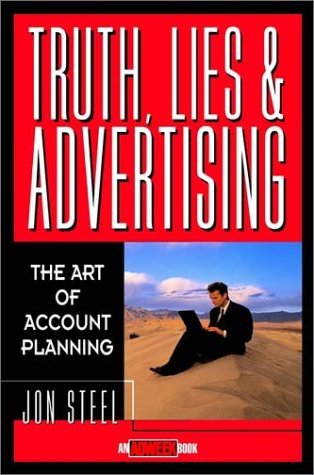 ในส่วนหนึ่งของชุดบทวิจารณ์หนังสือการตลาด เราได้ตรวจสอบ "ความจริง คำโกหก และการโฆษณา: ศิลปะแห่งการวางแผนบัญชี" ของจอน สตีล แม้จะมุ่งเน้นไปที่การโฆษณา เนื้อหาของหนังสือก็สามารถนำไปใช้กับบริการการตลาดสาขาอื่นๆ ได้อย่างเป็นไปได้ โดยเฉพาะอย่างยิ่ง เรากระตือรือร้นที่จะอ่านมุมมองของการวิจัยตลาดในแคมเปญโฆษณา
ในส่วนหนึ่งของชุดบทวิจารณ์หนังสือการตลาด เราได้ตรวจสอบ "ความจริง คำโกหก และการโฆษณา: ศิลปะแห่งการวางแผนบัญชี" ของจอน สตีล แม้จะมุ่งเน้นไปที่การโฆษณา เนื้อหาของหนังสือก็สามารถนำไปใช้กับบริการการตลาดสาขาอื่นๆ ได้อย่างเป็นไปได้ โดยเฉพาะอย่างยิ่ง เรากระตือรือร้นที่จะอ่านมุมมองของการวิจัยตลาดในแคมเปญโฆษณา
เป้าหมายของ Steel คือการนำเสนอรูปแบบการโฆษณารูปแบบใหม่โดยพิจารณาจากความซับซ้อนของผู้คนและอารมณ์ของพวกเขา โมเดลนี้รวมเอาความร่วมมือของผู้มีส่วนได้ส่วนเสียในแคมเปญโฆษณา:
- มุมมองทางธุรกิจของลูกค้า
- มุมมองที่สร้างสรรค์ของเอเจนซี่
- opinions and prejudices of the people at whom advertising is aimed; In other words, the consumer needs to be probed for insecurities, motivations, habits, and prejudices
ในการ "วิเคราะห์สามเหลี่ยม" มุมมองเหล่านี้ เป็นสิ่งที่ต้องระบุให้ใกล้กับความจริงมากขึ้น ต้นแบบนี้คือความซาบซึ้งต่อความสับสนวุ่นวาย เหตุผลของเหล็กก็คือผลรวมของทั้งหมดมากกว่าแต่ละส่วน ในทางกลับกัน หากอนุญาตให้มีมุมมองหนึ่งครอบงำ คุณภาพและประสิทธิผลของแคมเปญโฆษณาอาจได้รับผลกระทบ ความโกลาหล Steel บ่งชี้ว่ามีประโยชน์ในการส่งมอบงานที่ดีที่สุดให้กับลูกค้า
- สภาพแวดล้อมที่ส่งผลต่อการวิจัยด้านการโฆษณา
- มันทำให้พวกเขามีอารมณ์แบบไหน?
- โอกาส (ควรได้รับการสนับสนุน)
Steel ยังคงวาดเส้นขนานที่ไม่คาดคิดระหว่าง Quantum Physics และ Advertising โดยอ้างอิงถึงความสับสนวุ่นวาย ท้ายที่สุดแล้ว Steel บอกเป็นนัยว่าความสับสนวุ่นวายและความปรารถนาในมุมมองที่ขัดแย้งกันใน Quantum Physics นั้นคล้ายคลึงกับแนวทางของเขาในมุมมองที่หลากหลาย
Steel continues to define Advertising according to Jeff Goodby’s definition: getting into one’s mind and changing one’s mind, but not telling one how to think. Along these lines, Steel asserts that Advertising cannot sell something; instead it influences the mind, which can influence purchasing.
ศิลปะการโฆษณาหรือธุรกิจคืออะไร? Goodby กล่าวว่าการโฆษณาเป็นธุรกิจแห่งการเปลี่ยนแปลงความคิด ดังนั้น ดูเหมือนว่าการโฆษณาเป็นการผสมผสานระหว่างศิลปะและการพาณิชย์ โดยมุ่งไปสู่การค้า การรับรู้ว่าการโฆษณาส่วนใหญ่เป็นงานศิลปะเป็นปัญหา เนื่องจากทำให้เกิดปัญหาในการให้ความสำคัญกับผลประโยชน์ของครีเอทีฟโฆษณามากกว่าผลประโยชน์ของลูกค้า Steel บอกเป็นนัยว่าผู้ลงโฆษณาจำเป็นต้องตระหนักว่าวัตถุประสงค์ของลูกค้าคือการขายสินค้าหรือแนวคิด
อีกอย่าง การโฆษณาเป็นวิทยาศาสตร์หรือศิลปะกันแน่? Steel กล่าวว่าการโฆษณาไม่ใช่วิทยาศาสตร์เพราะละเลยความซับซ้อนของอารมณ์ความรู้สึกของมนุษย์ วิทยาศาสตร์สันนิษฐานว่าคุณสามารถแยกส่วนประกอบต่างๆ และสร้างสิ่งต่างๆ ขึ้นมาใหม่ตามแบบจำลองของเครื่องจักรโดย Margaret Wheatley ข้อมูลทางวิทยาศาสตร์ที่มากเกินไปสามารถมุ่งความสนใจไปที่ต้นไม้และละเลยป่าไม้ได้ตามที่ Steel กล่าว
Steel writes about the power of the unscientific method. He cites evidence that some of the best brains, including Einstein, Oppenheimer (a physicist), and Watson/Crick, deviated from the scientific method by combining science and art (intuition, fantasy). Steel implies that this occurred because these great thinkers realized that the scientific method could not explain everything.
ตามบริบทแล้ว การโฆษณาประสบปัญหาหลายประการในการเข้าถึงผู้บริโภค การโฆษณามุ่งเป้าไปที่ผู้คน และพยายามบอกพวกเขาว่าต้องทำอะไร ข้อความถูกใช้มากเกินไป ส่งผลให้ผู้คนไม่ชอบการโฆษณา Steel เสนอว่า Holy Trinity ในการโฆษณาประกอบด้วย:
- ความเรียบง่าย
- การใช้ความคิดเบื้องต้น
- ความคิดสร้างสรรค์
แนวคิดเกี่ยวกับการวิจัย
Steel asserts that clients assume that those on the outside share their same amount of knowledge, and that it was the role of the planner needs to change this. He indicates that the focus group moderator should have the power to introduce a completely new idea and deviate from the discussion guide. For example, he worked on a project on “Disability Insurance,” which by itself is a word that makes people shudder. Exploratory research was employed to allow the respondent to freely think and speak her thoughts. He found that respondents considered disability insurance as a necessary evil. As a result, the resulting ad campaign focused on the wide picture of the future and the realities that would impact some of the population. The message was that the company had your interests at heart.
Steel also claims that researchers need to look at what is not being said. Citing the example of a project for KPMG Peat Marwick, he had conducted many interviews with high-level executives. All research interviews consisted of the respondent telling the interviewer that what they were saying was all confidential. Hence, he came up with the idea to make a slogan conveying the exciting, stealthy, and confidential nature of what KPMG did.
ท้ายที่สุดแล้ว หนังสือเล่มนี้มีตัวอย่างโฆษณาเชิงสร้างสรรค์ที่เติมพลัง รูปแบบการเขียนที่อ่านง่ายสอดคล้องกับทฤษฎีโดยรวมของเขาเกี่ยวกับความเรียบง่ายและสามัญสำนึกในการโฆษณา ทฤษฎีเกี่ยวกับแคมเปญโฆษณามีประโยชน์ในการจัดทำแนวคิดแคมเปญโฆษณาที่มีประสิทธิภาพสูงสุด ความไม่พอใจเพียงอย่างเดียวของเราคือแนวคิดเกี่ยวกับการค้นคว้าไม่ได้เพิ่มคุณค่ามากนักจากผู้เขียนคนอื่นๆ ในประเภทนี้ เช่น ผู้แต่ง Clotaire Rapaille ของ "Culture Code"



